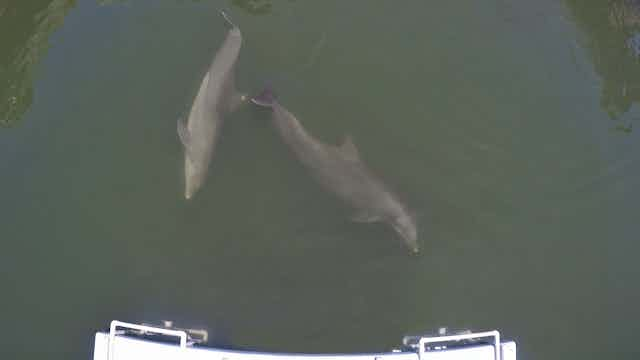Cooperation can be found across the animal kingdom, in behaviours such as group hunting, raising of young, and driving away predators.
But are these cooperating animals actively coordinating their behaviour, or are they simply acting individually to accomplish the same task at the same time?
In a study, published today in Proceedings of the Royal Society B, we showed that bottlenose dolphins actively coordinate their behaviours. That is, they can learn to work together and synchronise their actions to solve a cooperation task and receive a reward.
Read more: Male dolphins use their individual 'names' to build a complex social network
Testing teamwork
For this study, conducted at the Dolphin Research Center in the Florida Keys, we created a task in which pairs of dolphins had to swim across a lagoon and each press their own underwater button at the same time (within a 1-second time window).
Each trial began with both dolphins and their respective trainers located at the opposite side of the lagoon from the buttons, about 11 metres away. The trainers would either both give a “press the button” hand signal at the same time, or one trainer would give the signal first, while the second trainer asked her dolphin to wait up to 20 seconds before giving the signal.
If the dolphins pressed their buttons at the same time, a computer played a “success” sound, and the dolphins returned to their trainers for fish and social praise.
If the dolphins pressed their buttons at different times, a “failure” sound was played and the trainers moved on to the next trial.
The strict timing requirement meant they had to work together. If their goal was simply “press my button”, then when they were sent at different times, they would press at different times. To succeed, they had to understand their goal as “press the buttons together”.
The question, then, was whether the dolphin sent first would wait for the other dolphin before pressing its button, and whether they could figure out a way to coordinate precisely enough to press simultaneously.

Swim fast, or coordinate?
We found that the dolphins were able to work together with extreme precision even when they had to wait for their partner. Interestingly, their behavioural strategies and the coordination between them changed as they learned the task.
Keep in mind that the dolphins had to figure out that this was a cooperative task. There was nothing about the situation that told them in advance that the buttons had to be pressed at the same time.
To help them learn, we started by sending them simultaneously and gradually increased the timing difference between them.
When one dolphin figured out the game first, if their partner was sent first on a particular trial, they knew that the partner (who had not figured out the game) was not going to wait.
So in the early phases, we found that many successes were achieved not by the first dolphin waiting, but by the second dolphin swimming extremely fast to catch up.
But once both animals understood the task, this behaviour disappeared and the timing of their button presses became extremely precise (with the time difference between button presses averaging just 370 milliseconds).
This shows that both partners now understood that they didn’t need to swim fast to succeed; instead, they needed to synchronise their actions.
Synchrony in the wild
In the wild, dolphins synchronise their behaviour in several contexts. For example, mothers and calves will surface and breathe at the same time, and males in alliances will perform the same behaviours at the same time in coordinated displays.

The synchrony in these displays can be remarkably precise, and is thought to actively promote cooperation between partners.
Read more: Tackling the kraken: unique dolphin strategy delivers dangerous octopus for dinner
The results of our study suggest that this behavioural synchronisation that dolphins show in the wild may not be a hardwired response to a specific context, but may in fact be a generalised ability that they can apply to a variety of situations.
Kelly Jaakkola, director of research at the Dolphin Research Center, contributed to this research and this article. She can be contacted at kelly@dolphins.org.

